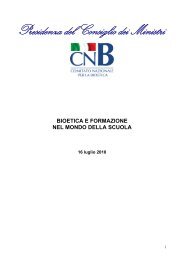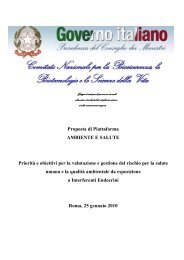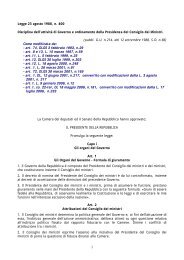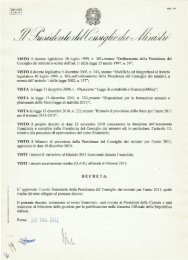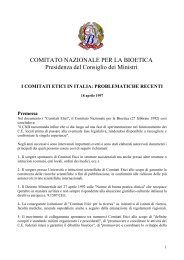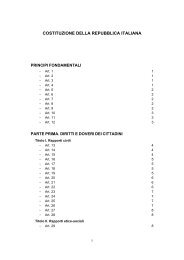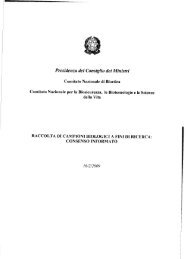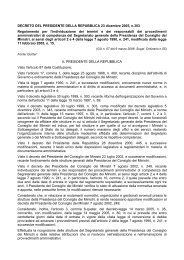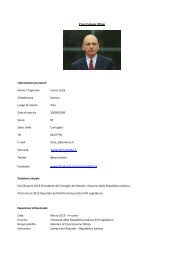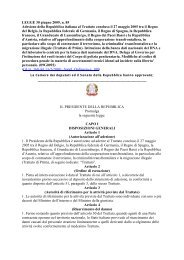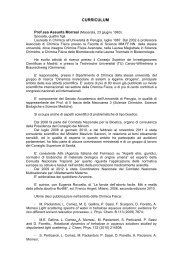President
President
President
You also want an ePaper? Increase the reach of your titles
YUMPU automatically turns print PDFs into web optimized ePapers that Google loves.
endocranial blood flow in both the brainstem and the cortex); single photon<br />
emission computer tomography (which documents the absence of metabolic<br />
activity in the whole encephalus); the evoked potentials (which document the<br />
absence of electrical activity both in the cortex and in the brainstem). It is not<br />
instead felt that the EEG is completely reliable and a variety of medical<br />
protocols agree with this conclusion.<br />
Therefore, the criteria are different (but only for what concerns the EEG),<br />
however the basic clinical concept is not different: the absence of all encephalic<br />
functions must be documented (awareness, consciousness, spontaneous<br />
respiration and stem reflexes) due to a known cause that has interrupted the<br />
endocranial haematic flow and the metabolic activity of encephalic tissue 223 .<br />
4. The cardiopulmonary criteria<br />
4.1. The recent debate<br />
Within the discussion about the criteria for ascertaining death, in most<br />
recent years there has been a return of interest towards the cardiopulmonary<br />
criterion, used when kidney transplants started (1960s – 70s) and then pretty<br />
much abandoned because of its modest “productivity” in terms of success 224 .<br />
This new interest has happened due to the need of increasing the pool of<br />
donors 225 and programmes have been initiated of organ removals not only from<br />
“heart-beating donors”, after having ascertained death with neurological criteria,<br />
but from “non-heart-beating donors” 226 , after a diagnosis of irreversible cardiac<br />
death 227 .<br />
A possibility that has been realised – in some way – thanks to the<br />
advancements in transplant surgery and in organ preservation techniques. The<br />
success of the removal of organs from “non-heart-beating donors”, however, is<br />
affected by the decrease of the waiting period after the cardiac arrest (which<br />
allows to minimise the absence of blood circulation, which permeates the<br />
organs) and by the speed of the attempt – although failed – to treat the patient<br />
in cardiac arrest and transport him/her to an intensive care unit. Finally, a team<br />
that is adequately prepared from an organisational and technical point of view,<br />
must be available.<br />
Therefore, the removal of organs in non-heart-beating donors today<br />
focuses our attention back on the organisational complexity and the difficulty of<br />
diagnosing death with cardiological criteria. An aim, this, which requires – as<br />
already mentioned – the shortening of the observation period of the organs’<br />
223 R. Proietti, La diagnosi, cit<br />
224 In 1997 this approach was called “innovative”, because it re-employed, with new methods<br />
and technologies compared to the past (cf. KOOTSTRA, J.K. KIEVIT, E. HEIMAN, The non<br />
heart-beating donor, “British Medical Bulletin”, 1997, 53, 4, p. 844).<br />
225 Due to the decrease, amongst young people, of death caused by brain damage brought on<br />
by cardio-vascular pathologies and the improvement in the diagnosis and care of serious brain<br />
damage. The removal of organs from “heart-beating donors” represents in some European<br />
countries – like the United Kingdom and Spain – 10% of the contribution of kidneys and – a<br />
little less – of liver and they are set out to be, with some care, also the source of lung removals.<br />
226 The expression “donation after cardiac/cardiopulmonary death” is also used.<br />
227 By ascertaining the irreversible interruption of the heartbeat, to which follows also the<br />
interruption of blood circulation, breathing functions and ischemic brain damage up to the<br />
colliquation of the encephalic mass.<br />
173




